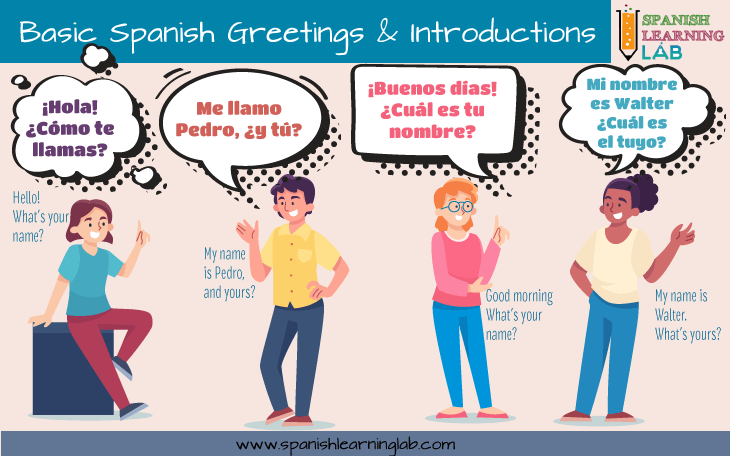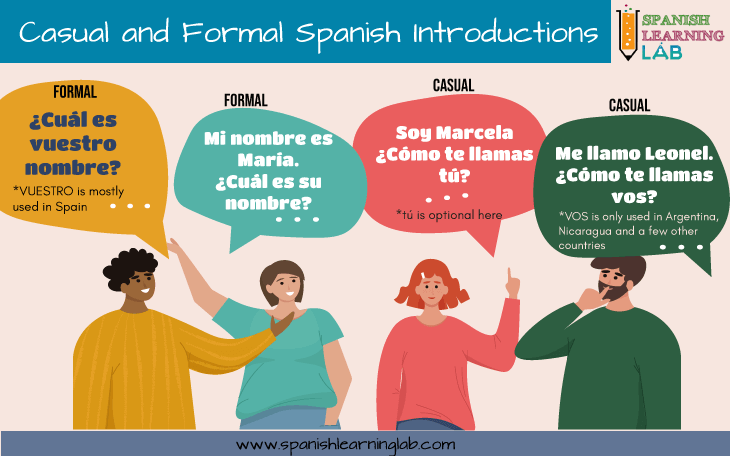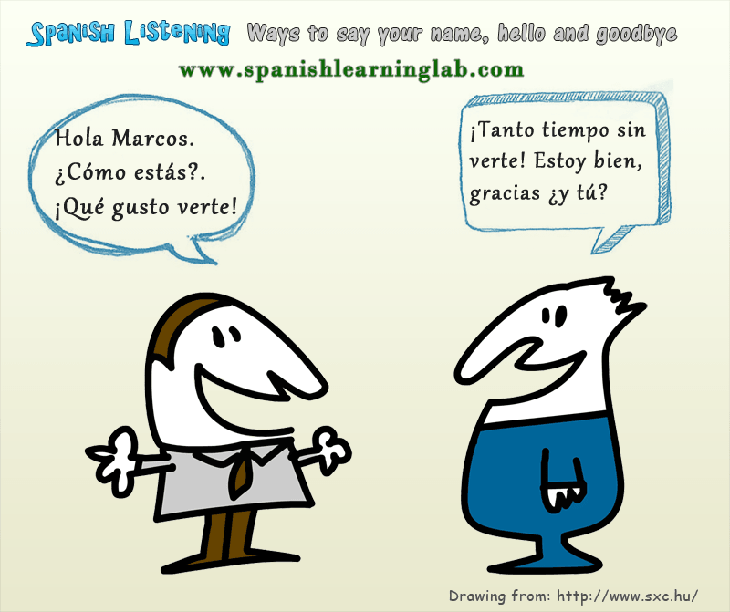There are several ways to say our name, greet people and say goodbye in Spanish. Most of these expressions have been covered in two separate lessons, one teaching how to introduce yourself and another about common greetings and farewells. This time we are going to focus on how to use Spanish greetings and introductions to hold basic conversations. The lesson includes four simple sample conversations in Spanish, as well a listening activity to test yourself. Let’s start…
Vocabulary review: Basic Spanish greetings and introductions
Firstly, we will review some of the vocabulary and sentence structure for common Spanish greetings and introductions. To introduce yourself, you can start with a phrase like “HOLA” or “BUENOS DIAS”. Then, you can say your name with: [ME LLAMO + NOMBRE] or [MI NOMBRE ES + NOMBRE] as in this example: “¡Hola! Me llamo Alex”. You can also say your name using the verb SER with the structure [YO SOY + NOMBRE] as in “Yo soy Alex”. To ask someone his or her name, we use ¿Cómo te llamas? or ¿Cuál es tu nombre? It is polite to say something like MUCHO GUSTO after you hear someone’s name.

Basic conversations with Spanish greetings and introductions
It is time to see how the vocabulary for “saludos y presentaciones” in use through basic conversations. Pay attention to the pieces of information before each dialogue.
Saying and asking names in Spanish
The first min-conversation shows how to say and ask for names in Spanish and use the greetings ¡Mucho gusto! and ¡El gusto es mío!, which would be the same as ¡Mucho gusto también!.
- Carlos: ¡Hola! Mi nombre es Carlos. ¿Cómo te llamas?
- Ana: ¡Mucho gusto Carlos! Me llamo Ana.
- Carlos: El gusto es mío
Formal vs Casual questions in Spanish
In the second conversation example, Ana will use a more casual or informal way to talk with the subject pronoun TÚ, whereas Carlos will reply formally by asking ¿Cuál es SU nombre? (USTED) instead of the casual question ¿Cuál es TU nombre? The possessive adjective makes the difference here.

- Ana: Tu nombre es Carlos, ¿verdad?
- Carlos: Sí, así es. ¿Cuál es su nombre?
- Ana: Yo soy Ana, la hermana de Jack.
- Carlos: Ahh…¡Es un placer conocerla!
Introducing a friend in Spanish
In the third basic conversation, we used “TANTO TIEMPO SIN VERTE” (Long time no see). Carlos introduces a friend in Spanish to Ana by using “PERMÍTEME PRESENTARTE A” + name. This dialogue also includes greetings and replies that are very useful when you meet someone for the first time.
- Carlos: ¡Hola! ¿Cómo estás?
- Ana: ¡Hola! Tanto tiempo sin verte. Yo estoy bien, ¿y tú?
- Carlos: Bien. Permíteme presentarte a mi novia. Su nombre es Jenifer.
- Ana: ¡Es un gusto conocerte Jenifer!
- Jennifer: Mucho gusto conocerte también.
A few other useful phrases
The last conversation example features the expression “MI NOMBRE ES + name” and then a few other important phrases that you may not find in a regular conversation of this kind, but are still important such as: UN MOMENTO POR FAVOR (wait a moment please), PUEDES ENTRAR (you can come in) and GRACIAS (thanks).
- Ana: Disculpe, Mi nombre es Ana. ¿Estoy en la lista?
- Recepcionista: Un momento por favor… uhmm, si aquí está. Puede entrar
- Ana: Gracias.
Interactive quiz: Saying hello and introducing people in Spanish
Grammar Note:
The verbs ENCONTRAR and CONOCER mean TO MEET in Spanish, but ENCONTRAR is used when we meet old friends or other people we have met before, eg. “Me encontré a Logan”, whereas CONOCER is more appropriate when you meet someone for the first time, eg. “Conocí a Logan”. ENCONTRAR and CONOCER are really important when having a conversation with Spanish greetings and introductions.
Listening Activity: Meeting old friends in Spanish
Key expressions in the audio:
- “Estaba un poco distraido” means I was a little distracted
- “Creo que es tiempo de irme” means I think it is time to go

Lesson assignment:
Find a partner and practice the phrases we studied in this lesson by making up your own dialogue using the vocabulary for Spanish greetings and introductions. You can choose any of the situations for introductions presented below, or any other situation you prefer.
- Role play #1: You are a new student in a Spanish class and meet a new classmate. Tell him your name and ask him how he is doing.
- Role play #2: You meet an old friend in a restaurant and introduce your boyfriend/girlfriend in Spanish to your friend.
Spanish introductions and greetings PDF Worksheets
- Greetings and farewells in Spanish – PDF Worksheet (Vocabulary)
- Getting to Know People in Spanish: PDF Worksheet (Speaking)
- Talking about Yourself in Spanish: PDF Worksheet (Speaking)
- Meeting People in Spanish – PDF Worksheet (Reading)
- Essential Phrases and Questions in Spanish – Dialogues in PDF

i like this site its very helpful
¡Gracias! We appreciate that 🙂